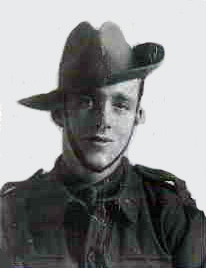Sydney Chadwick McDonald
From Our Contribution
 Ancestry.com | |
| Personal Information | |
|---|---|
| Date of Birth | 25 Sep 1899 |
| Place of Birth | Dublin, Ireland |
| Death | 14 Jul 1975, aged 75 |
| Place of Death | West Heidelberg, Victoria |
| Age at Enlistment | 19 years old (actual age 16) |
| Description |
5'6½" (1.69m) tall ; 147 lbs 66.678 kg ; ruddy complexion ; brown eyes ; dark brown hair |
| Occupation | Farm hand |
| Religion | Presbyterian |
| Address | Kelmscott, Western Australia |
| Next of Kin | Mother , Mrs Elizabeth Agnes McDonald |
| Military Information | |
| Reg Number | 2101 |
| Date of Enlistment | 20 Sep 1915 |
| Rank | Driver |
| Unit/Formation | 10th Light Horse Regiment, 14th Reinforcement, transferred to 24th FAB, and then 28th Battalion |
| Date of Embarkation | 16 Feb 1916 ‒ 13 Mar 1916 |
| Ship Embarked On | HMAT A69 Warilda |
| Date of Return | 16 Jun 1919 ‒ 24 Jul 1919 |
| Ship Returned On | RMS Ormonde |
| Fate | Returned to Australia |
| Monument | none currently |
| Medals |
British War Medal Victory Medal |
Pre War
War Service
Entering camp on 20 Sep 1915, it was not until 12 Feb 1916, just before he sailed to Egypt, that he was allocated to the 14th reinforcement draft for the 10th Light Horse Regiment. He had previously trained with the 20th Depot Company, the 4th Depot Squadron and the 5th Depot Squadron.
Soon after arrival in Egypt, Syd was transferred to Artillery at Heliopolis on 1 Apr 1916 where he mustered as a Gunner with 4th Division Ammunition Column. Within 2 months he became a temporary Driver, and after arriving in France on the SS Oriana on 13 June, Syd was taken on strength by the 24th Field Artillery (Howitzer) Brigade from the 4th Division Ammunition Column, and posted to the 112th Battery.
In late Jan 1917 after a reorganisation of artillery he was shifted to the 12th Field Artillery Brigade, but remained in the 112th Battery. In Jul 1917 he was charged with: 1) At Steenwerck on 23 Jun 1917 when ordered by Lt Col J. Atkinson to halt, he failed to do so; 2)Disobedience of GRO 430 in that he at Steenwerck on 23 Jun 1917 galloped a horse on a paved road. His punishment was 14 days Field Punishment No.2 (see notes) and a fine of £3/10/- ($7). Three months later on 3 Oct 1917 he was charged with having a light burning after sundown. For this he was awarded another 14 days Field Punishment No.2 (see notes).
Sydney proceeded overseas to France through Southampton on 23 Nov 1917. On 20 Jan 1918 he was ill with dermatitis, and spent time at the 3rd General Hospital in Le Tréport, before transferring to UK on 29 Jan 1918 aboard HMHS Panama. He spent from 30 Jan - 25 Mar 1918 in the Royal Victoria Hospital and 3rd Australian Auxiliary Hospital from 26 - 28 Mar 1918.
On 17 May 1918 Syd was admitted to the 1st Australian Dermatological Hospital] at Bulford for four days and didn't return to France until 27 Sep 1918 via Folkestone. When he did so it was as a reinforcement for the 28th Battalion.
In January 1919 he fell foul of Military authorities again, being charged with AWOL and Drunkenness.
Discharged 5th Military District 15 Sep 1919.
Post War
In 1921 Sydney married Iris Polkinghorne in Fremantle. Iris was no longer with Sydney from the early 1930s, and in 1936, an Iris McDonald married Walter Robinson in the Murchison, so it would appear that Iris and Sydney had been divorced.
Electoral Roll entries: 1925 a telephone employee living at Perth road, Albany; 1930 - 31 in Richmond street Cue with Iris, a linesman; 1934 alone at Kulin; 1936 - 1937 at 115 Brandon street, South Perth; 1943 a linesman at Mundiwindi; 1949 an estimating foreman at 30 Forrest street, North Perth; 1954 - 1958 at 327 Pier street, line inspector; and then no occupation later in the year; 1963 a pensioner at 10 Crossland street, Carnarvon; 1972 at 89 Rennie crescent, Hilton.
During WW2 Sydney enlisted in the Citizen's Military Forces with regimental N0 W76996 in Carnarvon.
In 1972 the 10th Light Horse Association wrote to the Military authorities on his behalf seeking replacement copies of his medals, and there is a note of file showing a connection to 53061 Sergeant S.C. McDonald of 103 Signals Squadron, Lavarack Barracks, Townsville.
Notes
Field punishment could be awarded by a court martial or a commanding officer for any offence committed on active service. There were two categories of field punishment. Field punishment No. 2 consisted of heavy labouring duties, and several hours a day shackled . All offenders awarded field punishment would march with their unit, carry their arms and accoutrements, perform all their military duties as well as extra fatigue duties, and be treated as defaulters.
Memorialised at Karrakatta